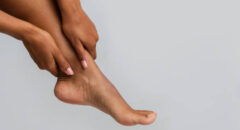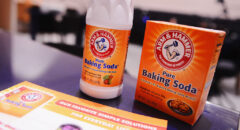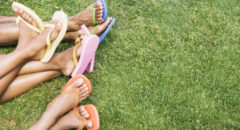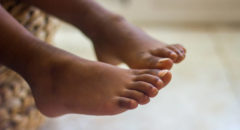
The perfect pair of heels can help set off your look, but at what cost? Wearing high heels may cost you more in the long run because of the side effects to your health. Women often make sacrifices for foot fashion, but studies have shown that these four, five and six-inch shoes can be costly in more ways than one. They take their toll on your spine, hips, knees, ankles and feet while altering your posture.
But regular stretching of the foot and calves will loosen hamstrings and work to alleviate some of the pain, pressure and effects from your high heels. Stretching before and after long periods in heels and sneaking in some footwork during breaks in your day will help as well.
Here are three foot stretching exercises that can help:
I. The "Cute Shoe" Stretch:
- Lay a book with a one-inch spine on the floor.
- While standing, place the ball of your right foot on the book and rest your heel on the ground.
- Bend forward at the waist and try to grab the toes on the book. (If you need to bend your knees a little, that’s OK).
- Hold for 30 seconds.
- Switch feet. Repeat two to three times.
- Gradually increase the height of the book by 1-inch increments per week to a maximum of 3 inches.
Dangerous Heights: What High Heels Really Do To Your Feet
II. The "My Dogs Are Barking" Towel Foot Stretch:
This move loosens up your calves and provides relief to the soles of your feet.
- Sit on the floor and stretch both of your legs out in front of you.
- Bend your left leg and keep your right leg stretched out on the floor.
- Using a hand towel with each end in one of your hands place the ball of your right foot in the center of the towel.
- Pull back on the towel towards your chest while keeping the right leg straightened.
- To intensify the stretch begin to bend the right knee slightly.
- Hold for 10-15 and then repeat with the other foot.
READ: Scientist Creates Designer High Heels that can be Worn with No Pain
III. The "Two-Part" Ankle Strengthening Exercises:
These two stretches are aimed at strengthening your ankles so as to be less affected by the wear and tear from wearing high heels.
Ankle lifts: Tie a belt or similar sized piece of rope around both ends of a light dumbbell, so it forms a...
... triangle when you hold it by the center of the belt or rope. Sit on a counter and insert your feet into the triangle and lower your feet with the weight. Using your ankles, lift the weight repeatedly.
Ankle turns: While sitting on a chair, slide a jump rope or resistance band under one foot. Holding onto the rope, pull left so your ankle tilts left.
Going against the force caused by your arms, push your ankle right. With your ankle now tilted right, pull right and push your ankle to the left. Do this repeatedly and then do it with your other foot.
RELATED: Are Your Shoes Ruining Your Life?
It’s also important to understand that the slope of the shoe is more important than heel height when it comes to comfort.
Look for a platform sole to decrease the angle between the heel and the ball of the foot, so your weight can be more distributed across the entire foot. A thicker heel also spreads your weight more evenly and decreases the risk of spraining your ankle.
Also, avoid narrow toe boxes that squeeze toes. Narrow, pointy high heels are the perfect storm for foot pain.
READ: Wearing the Wrong Shoes? The Impact Could Be Worse Than You Think
Ideally, a pointed shoe will narrow after the toe box to give the illusion of length while providing ample space for your foot.
Finally, high heels should fit snugly and hold the foot firmly in place. High heels that are slightly loose cause your foot to slide back and forth. That friction is the culprit behind blisters, bleeding feet and ripped toenails.








